
Parmelia is a genus of medium to large foliose lichens. It has a global distribution, extending from the Arctic to the Antarctic continent but concentrated in temperate regions. There are about 40 species in Parmelia. In recent decades, the once large genus Parmelia has been divided into a number of smaller genera according to thallus morphology and phylogenetic relatedness.
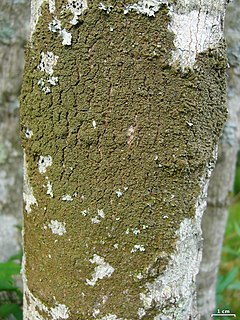
Melanohalea is a genus of foliose lichens in the family Parmeliaceae. It contains 30 mostly Northern Hemisphere species that grow on bark or on wood. The genus is characterized by the presence of pseudocyphellae, usually on warts or on the tips of isidia, a non-pored epicortex, and a medulla containing depsidones or lacking secondary compounds. Melanohalea was circumscribed in 2004 as a segregate of the morphologically similar genus Melanelia.

Melanelixia is a genus of foliose lichens in the family Parmeliaceae. It contains 15 Northern Hemisphere species that grow on bark or on wood. The genus is characterized by a pored or fenestrate epicortex, and the production of lecanoric acid as the primary chemical constituent of the medulla. Melanelixia was circumscribed in 2004 as a segregate of the related genus Melanelia.

Parmelia saxatilis, commonly known as the salted shield lichen or crottle, is a species of foliose lichen in the family Parmeliaceae. Several morphologically similar species, formerly lumped together, are now distinguished by their DNA.
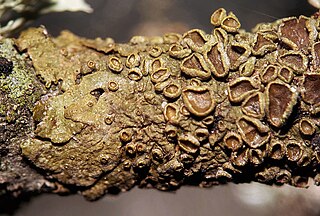
Melanohalea subolivacea, commonly known as the brown-eyed camouflage lichen, is a species of foliose lichen in the family Parmeliaceae.

Punctelia rudecta, commonly known as the rough speckled shield or the speckleback lichen, is a North American species of foliose lichen in the family Parmeliaceae. This species can be readily identified by the light color of the thallus underside, the relatively large lobes at the edges of the thallus, and the tiny white pores present on the top of the thallus that are characteristic of the genus Punctelia. The lichen is quite abundant and widespread in the eastern and southeastern United States, although it also occurs in Canada and northern Mexico, but is less common in these regions. The lichen usually grows on bark, and less commonly on shaded rocks. There are several lookalike Punctelia species; these can often be distinguished from P. rudecta by differences in distribution or in the nature of the reproductive structures present on the thallus.
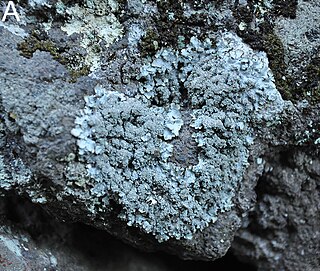
Punctelia guanchica is a species of foliose lichen in the family Parmeliaceae that is only known from the Canary Islands. It is similar in appearance and morphology to the North American Punctelia rudecta, and was historically misidentified as that species until molecular phylogenetic evidence showed it to be a distinct species. It differs in having thicker isidia that develop from the centre of the pseudocyphellae, and it mainly grows on rocks.
Punctelia ulophylla is a species of foliose lichen in the family Parmeliaceae. It is found in Europe, where it grows on the bark of a variety of trees.

Punctelia reddenda is a widely distributed species of foliose lichen in the family Parmeliaceae. It occurs in Africa, Europe, North America, and South America, where it grows on bark and on rock.
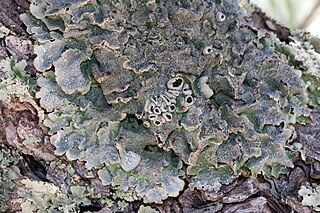
Punctelia hypoleucites, commonly known as the southwestern speckled shield lichen, is a species of foliose (leafy) lichen in the family Parmeliaceae. First formally described by Finnish botanist William Nylander as a species of Parmelia, it was transferred to the genus Punctelia in 1982. The lichen is found in Africa, North America, and South America, where it grows on the bark of both hardwood and coniferous trees. Its greenish-grey thallus is covered with tiny white pseudocyphellae – minute holes in the thallus surface that facilitate gas exchange. Some macroscopic features that help distinguish this species from other related members of the genus include the presence and the structure of the apothecia, the absence of asexual surface propagules, and the light brown color of the thallus undersurface. Chemically, the presence of lecanoric acid in the medulla and atranorin in the cortex help distinguish it from lookalikes.

Punctelia bolliana, the eastern speckled shield lichen, is a species of foliose lichen in the family Parmeliaceae. It is found in North America, with a distribution extending from the Canadian province of Ontario south to the central and northeastern United States and Mexico. It grows on the bark of both deciduous trees and coniferous trees. The combination of characteristics that distinguishes this species from others in genus Punctelia are the absence of the vegetative propagules isidia and soralia, a pale brown lower thallus surface, and the presence of the secondary chemical protolichesterinic acid in the medulla.
Parmelia ambra is a fossilised species of foliose lichen in the family Parmeliaceae. Found in Dominican amber and described as a new species in 2000, the fossil has been used in subsequent studies of lichen evolution.
Parmelia mayi is a species of foliose lichen in the family Parmeliaceae. It is found in the northern Appalachian Mountains of eastern North America, where it grows on rocks and on the trunks of paper birch and balsam fir. Parmelia mayi is morphologically indistinguishable from Parmelia saxatilis, but is distinct in its distribution, chemistry, and genetics.
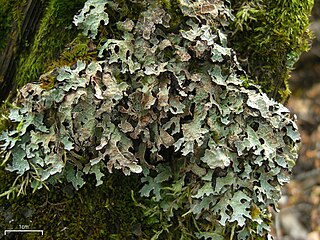
Parmelia barrenoae is a species of foliose lichen in the large family Parmeliaceae. It was formally described as a new species in 2005. Before this, it was lumped together as one of several lichens in the Parmelia sulcata group—a species complex of genetically distinct lookalikes. Parmelia barrenoae is widely distributed, occurring in Europe, western North America, Africa, and Asia.

Parmelia fraudans is a species of foliose lichen in the family Parmeliaceae. It is found in Europe and North America, where it grows on rocks.
Xanthoparmelia isidiovagans is a species of foliose lichen in the family Parmeliaceae

Neoprotoparmelia amerisidiata is a species of corticolous and crustose lichen in the family Parmeliaceae. Found in the southeastern United States, it was formally described as a new species in 2018 by Garima Singh and André Aptroot. The type specimen was collected by James Lendemer in the Sapelo Island Wildlife Management Area ; here the lichen was found growing on oak bark. It has a thin, shiny, pale olive-green to olive-grey thallus with numerous isidia. Secondary chemicals in the lichen that are detectable with thin-layer chromatography include alectoronic acid (major), and lesser to trace amounts of dehydroalectoronic acid and β-alectoronic acid. The specific epithet amerisidiata refers to both its North American distribution and the presence of isidia. It is known from North Carolina, Alabama, Georgia, Mississippi, and Florida.

Neoprotoparmelia brasilisidiata is a species of corticolous (bark-dwelling), crustose lichen in the family Parmeliaceae. It has a neotropical distribution, and has been recorded from Costa Rica, El Salvador, and Brazil, where it grows in parks and open areas. The lichen was formally described as a new species in 2018 by Garima Singh, Marcela Eugenia da Silva Cáceres, and André Aptroot. The type specimen was collected by Cáceres and Aptroot in the Serra de Itabaiana National Park, at an altitude of about 200 m (660 ft). The specific epithet brasilisidiata refers to both the country where it was first scientifically documented, as well as the presence of isidia. The lichen contains secondary compounds that can be detected using thin-layer chromatography, including alectoronic acid (major), and minor to trace amounts of dehydroalectoronic acid and β-alectoronic acid. When shone with a UV light, the medulla of the thallus and the isidia have a greenish white glow; this characteristic can be used to help distinguish it from other similar crusts with isidia.
Neoprotoparmelia capitata is a species of corticolous (bark-dwelling) and crustose lichen in the family Parmeliaceae. It is found in eastern North America.
Parmelia isidiiveteris is a fossilised species of foliose lichen in the family Parmeliaceae. It was found in Dominican amber and described as a new species in 2000. It was tentatively placed in the genus Parmelia although its true generic placement is difficult to determine with only a single specimen available for analysis.













